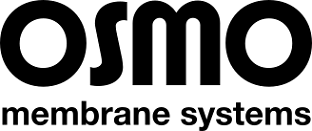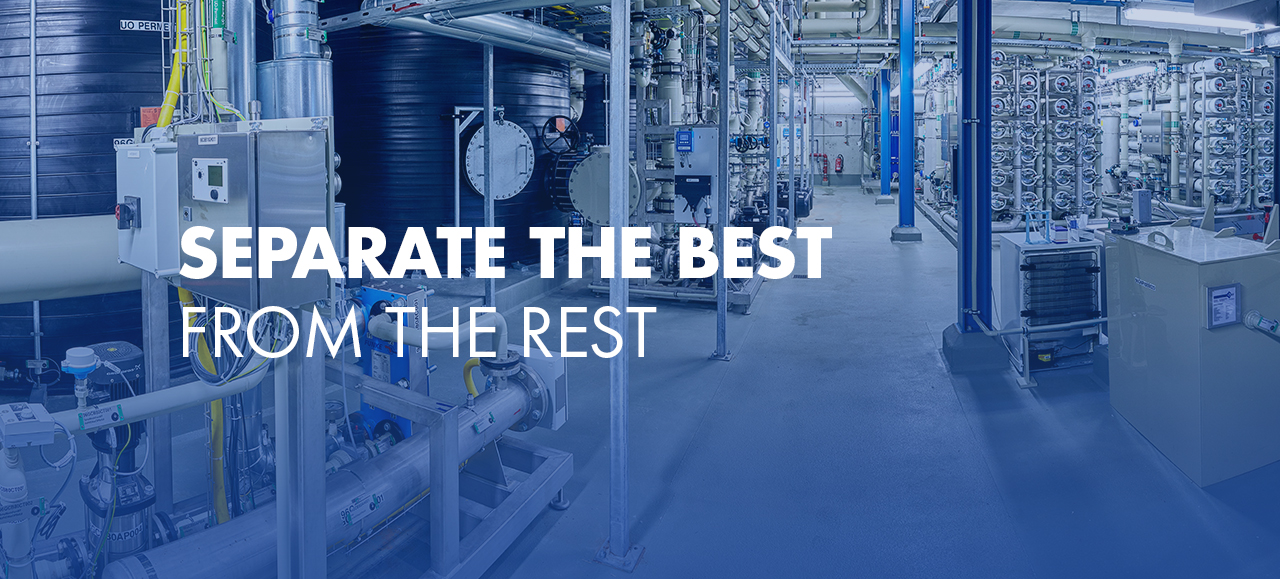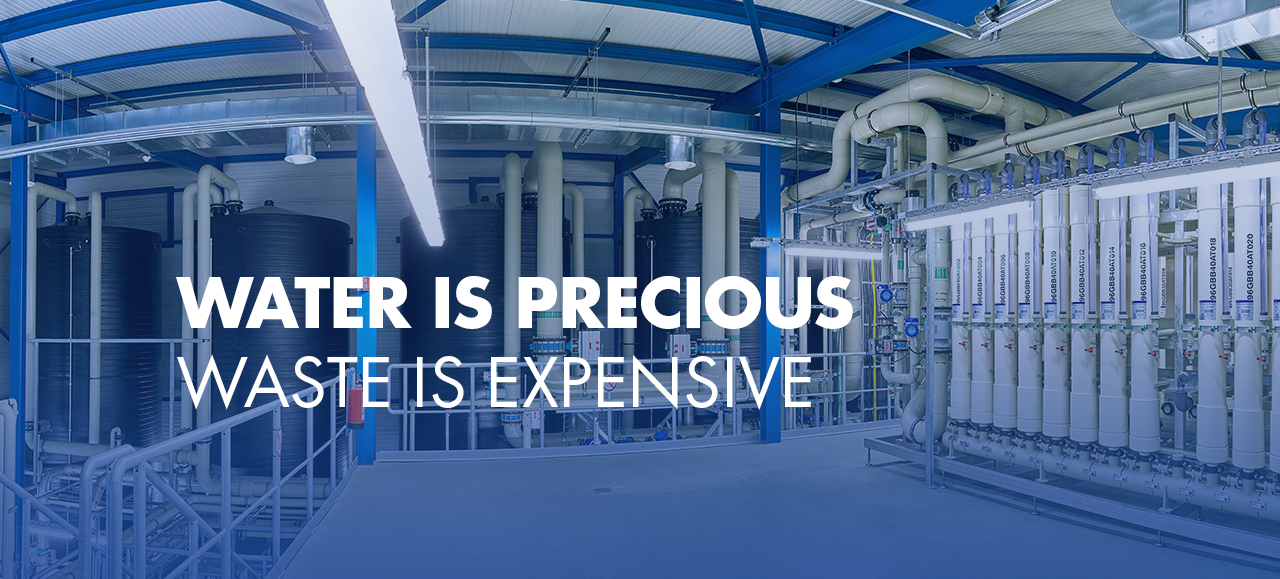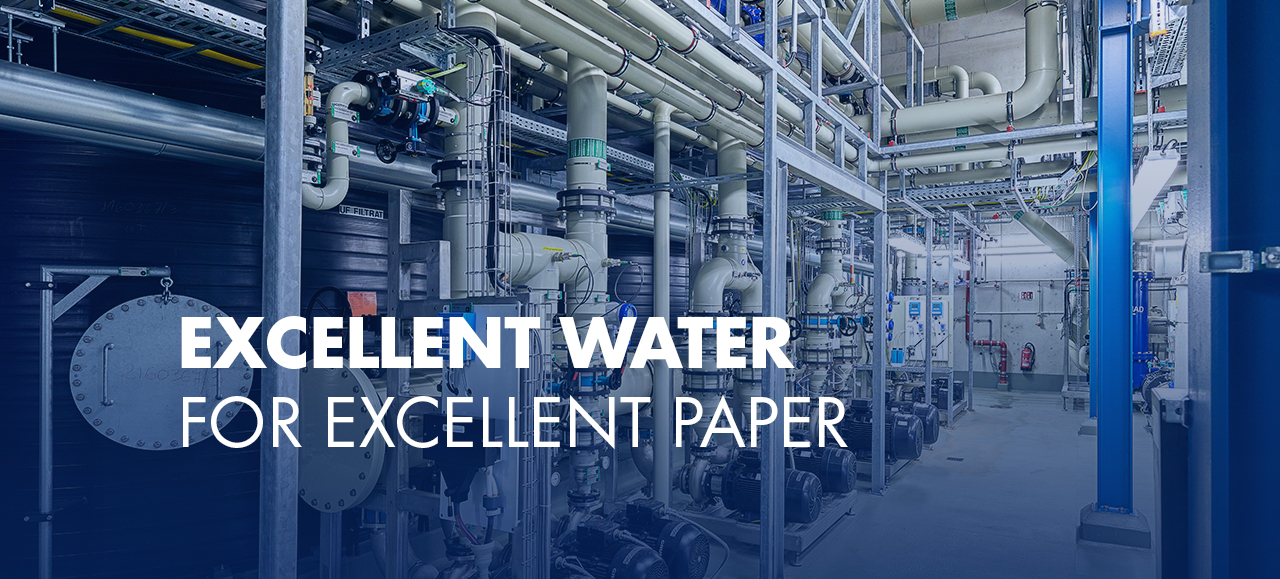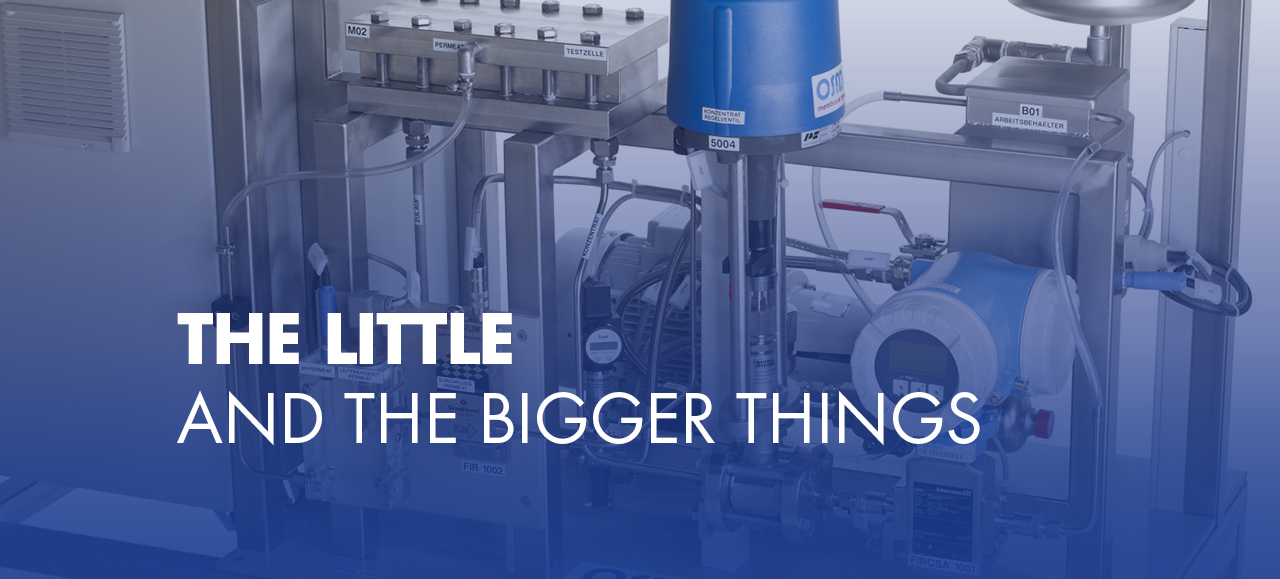| Safeguarding industrial water supplies in the face of declining groundwater levels by using alternative water sources In order to secure the supply of the increasingly scarce resource water as industrial water, the development of alternative sources such as river water or the recycling of wastewater for reuse is an important option. Membrane technology can be adapted to a wide range of water sources and quality requirements, making it an essential building block for tapping alternative water sources. Read about examples of OSMO plants that show how well or city water can be reliably and sustainably replaced by river water or wastewater . Source: Special industrieWASSER 01/2022 |
open article |
| Project of the Century at Paper Manufacturer - Synergy Project of OSMO and GAW
OSMO supplied a state-of-the-art river water treatment plant for the production of solids-free process water based on ultrafiltration technology for a new paper mill and the make-up water plant as well as the condensate purification plant for the paper mill's boiler house, which will produce water with the highest qualities for the newly installed gas and steam turbines. Source: IM Team GAW No. 01 2020 |
open article |
| OSMO supplied best separation technology for milestone phosphorus recycling project OSMO has already supplied the membrane separation stage for the pilot plant installed at REMONDIS since 2015. The pilot plant was first used at the Kohlbrandhöft sewage treatment plant in Hamburg. Following the successful pilot phase, a large-scale plant is now being implemented in Hamburg by Hamburger Phosphorrecyclinggesellschaft mbH, a joint venture between REMONDIS and Hamburg Wasser. Source: IM Team GAW No. 01 2019 Source: Quelle: Wasser und Abfall 04/2021 |
open article (Wasser und Abfall 04/2021) Link to original article on springer professional
|
| Water is a precious resource OSMO identifies potential savings in existing plants. Such optimisations usually pay for themselves between 6 and 24 months. Thus, they make sense not only from a technical but also from an economic point of view. Source: IM Team GAW No. 01 2018 |
open article |
| Drinking water production by ultrafiltration The ultrafiltration system is designed and built according to the high requirements of the Drinking Water Ordinance and the DVGW regulations. The mixed raw water from several springs and deep wells has a turbidity of approx. 40 FNU during rain events. This turbidity is filtered to <0.2 FNU. The water produced in this way is germ-free. This is followed by UV radiation and chlorination according to drinking water regulations. Source: IM Team GAW No. 01 2015 |
open article |
| Preparation of lithium salt Lithium-ion batteries are considered to be the energy storage devices of the future and are indispensable, especially for electromobility. To expand its lithium salt production capacity, one of the world's most renowned specialty chemicals manufacturers has ordered another ultra-high pressure reverse osmosis plant. The three-stage ultra-high pressure reverse osmosis concentrates lithium up to 120 times. Source: IM Team GAW No. 02 2014 |
open article |
| Increasing the permeate recovery with Factor X
Well water is desalinated to cooling tower make-up water in Namibia using multi-stage reverse osmosis. Limited water resources require a high recovery rate: 82 - 87% was achieved using Factor X, and this at a very high silica load. In addition, the entire plant, including the air-conditioned control cabinet and the valves of the upstream deferrisation/demanganisation filter, is housed in 2 x 40" containers. Source: IM Team GAW No. 01 2014 |
open article |
| Successful development work in the application of acid treatment
In close cooperation with a customer from the surface technology sector, OSMO has developed a new process for the recovery of spent phosphoric acid baths from printing plate production. Printing plates are pickled using phosphoric acid, which contaminates the pickling bath with small amounts of aluminium. The successful piloting of nanofiltration was followed by the commissioning of several plants, saving 75% of the fresh acid and reducing the amount of waste to only about 17% of the previous volume. Source: IM Team GAW No. 01 2013 |
open article |
|
OSMO supplies further river water treatment plant for chemical park Within the scope of a modernisation of an existing water treatment plant of a chemical park in southern Germany, OSMO Membrane Systems was commissioned with the engineering and delivery of a modern water treatment plant. The plant technology consists of prefiltration, ultrafiltration and reverse osmosis. This process engineering addition in the feed to the existing ion exchanger plant saves ≥ 90% of the regeneration chemicals. Source: IM Team GAW No. 01 2012 |
open article |
|
OSMO also builds laboratory scale The Vienna University of Technology, as well as other universities and research institutions, ordered a MemCell plant to carry out flat membrane tests with minimal effort. This laboratory-scale plant is used to determine specific parameters for the treatment of aqueous solutions by means of ultrafiltration, nanofiltration and reverse osmosis. This unit here is designed for tests at higher temperatures, possibly also for tests with lignin. Source: IM Team GAW No. 02 2011 |
open article |
|
Lignin recovery by ultrafiltration The newly developed process uses a ceramic membrane to separate high-quality and highly concentrated lignin sulphonate from bleaching wastewater of the paper and pulp industry. This means a reduction in COD content and the possibility of reusing the lignin sulphonate as a binder for pellets or chipboard or as a substitute raw material for adhesives, resins, fillers or as a feedstock for biodiesel. Source: IM Team GAW No. 01 2011 |
open article |
|
Water purification for paper manufacturer OSMO supplies the appropriate plant technology for the steam generation and the cooling circuit of the paper manufacturer. Altogether, the plant consists of deferrisation/demanganisation, reverse osmosis and downstream softening as well as membrane degassing. This combination of processes efficiently reduces operating costs. The customer has already had an OSMO plant since 2004. Source: IM Team GAW No. 01 2011 |
open article |
|
Water purification for dialysis membranes The manufacturer of dialysis membranes in eastern Germany ordered plant systems for demineralised and desalinated water and membrane degassing to remove dissolved CO2 from the water, also with a view to low operating costs. Source: IM Team GAW No. 01 2011 |
open article |
| Paper manufacturer works with OSMO technology
OSMO built a customised full desalination boiler feedwater purification system for an existing industrial power plant of a renowned German corrugated paper manufacturer without interrupting steam production. The plant technology includes pre-filtration, conditioning, reverse osmosis and downstream softening to reduce operating costs. Reverse osmosis and softening can also be operated separately in an emergency, which increases the availability of the plant. The implemented automation enables scale control (prevention of maximum concentration) and remote maintenance is possible through visualisation. During the construction phase, OSMO produced demineralised water using a mobile containerised plant. Source: IM Team GAW No. 01 2010 |
open article |
|
Plant technology for landfill in Hanover The treatment of landfill leachate by reverse osmosis means landfilling without negative environmental impacts. The complete plant consists of a combination of nanofiltration and reverse osmosis. The permeate produced can be discharged into the receiving water or used as service water at the landfill. The concentrate is returned to the landfill body. Source: IM Team GAW No. 01 2009 |
open article |
| Ultrafiltration for ink wastewater reduction in use
The ultrafiltration plant reduces the solids concentration, COD, AOX and heavy metal concentrations such as copper, so that the wastewater can be discharged into the municipal sewage treatment plant. Source: Im Team GAW No. 01 2008 |
open article |
|
Ultrafiltration for automotive supplier The modernisation of an existing cathodic dip painting - ultrafiltration at an automotive supplier in the Schweinfurt area went off without a hitch on a production-free weekend. Source: Im Team GAW No. 01 2008 |
open article |
|
Surface water purification The concept of surface water purification by ultrafiltration prevailed in the Europe-wide tender of an energy company. The entire purification system consists of multi-layer filters, ultrafiltration, reverse osmosis, membrane degassing and conventional mixed-bed polishers. With an ultra-pure water quality of ≤ 0.2 µS/cm, the water produced complies with VGB guideline 4501. Ultrafiltration ensures high availability for the entire plant. Source: IM Team GAW No. 02 2007 |
open article |
|
Treatment of flexo ink water A combination of nanofiltration and ultrafiltration reduces the amount of ink wastewater in a well-known corrugated board production company. The NF permeate is of discharge quality and the ink concentrate can be reused as printing ink on condition that it is treated according to type. In addition to reducing the impact on the environment, this investment also lowers production costs. Source: IM Team GAW No. 01 2007 |
open article |
|
Reverse osmosis construction for high chloride loads Due to the wastewater composition with high corrosion potential, a complete reverse osmosis plant was constructed using chloride-resistant special steel and in sanitary design. This allows the plant to be heated to ≤ 80°C to reduce the biofouling that occurs. Source: IM Team GAW · No. 01 2006 |
open article |
|
Recycling by high-pressure reverse osmosis in the chemical industry A reverse osmosis unit was built for a large company in the chemical industry, which separates organic substances from process condensate at high pressure (at approx. 100 bar) and returns them to the material cycle. With its 160 winding elements divided into 5 membrane stages, the plant is probably one of the largest high-pressure reverse osmosis units in the chemical industry worldwide. Source: IM Team GAW · No. 01 2006 |
open article |
|
Treatment of nitrate-containing wastewater using high-pressure reverse osmosis Conventional wastewater treatment processes remove the wastewater load simply and cost-effectively, but recovery and reuse of the water constituents is usually not possible. Selective membrane processes, on the other hand, make previously unused resources economically attractive, as the example of heavily nitrate-polluted wastewater treatment shows. The piloting of the treatment by high-pressure reverse osmosis was subsidised by the German Ministry for the Environment, Nature Conservation and Nuclear Safety with 2.6 million €. OSMO Membrane Systems supplied the pilot plant in container design and the large-scale plant ordered after successful piloting. Sources: CHEMIE TECHNIK · April 2006, IM Team GAW No. 02 2010 |
|
|
Unconventional treatment of waste water containing nitrates In cooperation with the BFI VDEh - Industrial Research Institute and funded by the BDU, OSMO developed a combination of diffusion dialysis, electrodialysis and membrane electrolysis. This process combination reduces nitrate emissions in wastewater and recycles stainless steel pickling acid and metals. Technical innovations have doubled the service life of the anodes compared to a reference plant at the same customer in Sweden, thus halving the operating costs. Sources: IM Team GAW No. 01 2005, IM Team GAW No. 02 2006 |
|
|
River water purification with ultrafiltration and reverse osmosis Purification of river water for boiler feed saves expensive drinking water. For the production of process water, many companies rely on high-quality well or drinking water supplies. But stricter environmental regulations are steadily restricting the sourcing of these supplies and increasing costs. An investment in modern membrane technology to produce boiler feed water from river water at low cost can therefore be worthwhile. The process used here is based on ultrafiltration with downstream reverse osmosis. Source: magazine "CHEMIE TECHNIK" No. 5 2003 (32nd year) |
open article |
